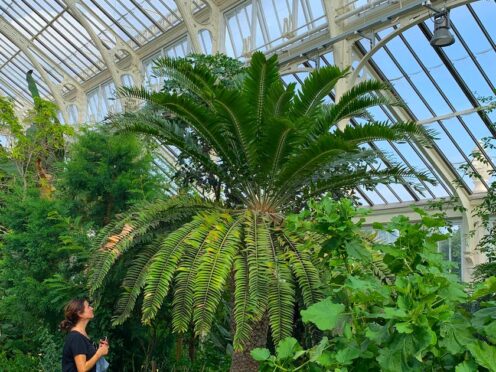
Artificial intelligence (AI) has been enlisted to search for a female partner for the only known, male, plant from a species that is thought to be extinct in the wild.
A research project led by the University of Southampton is using drones and AI to search the Ngoye Forest in South Africa, where the only known Encephalartos woodii, or E.woodii, was found.
And if the hunt for a female in the forest does not succeed, the researchers are also exploring the potential to change the plant’s sex so it can reproduce naturally.
E.woodii is a type of plant known as a cycad – the oldest surviving seed-bearing plants with a lineage that dates back 300 million years, to before the dinosaurs.
They are now one of the most threatened plant groups in the world, hit by habitat loss and a global trade in valuable wild cycads, conservationists warn.

The male E.woodii plant was discovered in the Ngoye Forest in 1895, and moved several years later for safe keeping, with samples sent to botanical gardens, including Kew Gardens in London, where the species is still propagated and grows today.
But all propagated samples are male clones, and so cannot naturally reproduce, and the Ngoye Forest has never been fully explored to find out if a female could exist, the team behind the project said.
Initial drone flights in 2022 took tens of thousands of images and used a multispectral sensor to capture features that cannot be seen with the naked eye, including seeing if plants are living or dead and identifying species.
No female E.woodii was found, so more drone imaging is taking place, with AI trained to recognise plants by their shape, to help in the hunt for an elusive partner.
So far 195 acres of the 10,000-acre forest have been assessed.
Dr Laura Cinti, from the University of Southampton’s Winchester School of Art, a research-based artist working with biology, is leading the project with Dr Howard Boland, a creative technology expert working in AI, and South Africa-based Dr Debbie Jewitt, a conservation scientist and drone pilot.
Dr Cinti said: “This plant is, as far as we know, extinct in the wild. I was very inspired by the story of the E.woodii – it mirrors a classic tale of unrequited love.
“I’m hopeful there is a female out there somewhere, after all there must have been at one time.
“It would be amazing to bring this plant so close to extinction back through natural reproduction.”
She said the project used an image recognition algorithm to recognise plants by shape, generating images of plants and putting them in different settings to train the model to recognise them.
And Dr Cinti is also working on a project to investigate whether chemical or physiological manipulation can be used to change the sex of E.woodii.
“There have been reports of sex change in other cycad species due to sudden environmental changes such as temperature, so we are hopeful we can induce sex change in the E.woodii too,” she said.

Enjoy the convenience of having The Sunday Post delivered as a digital ePaper straight to your smartphone, tablet or computer.
Subscribe for only £5.49 a month and enjoy all the benefits of the printed paper as a digital replica.
Subscribe